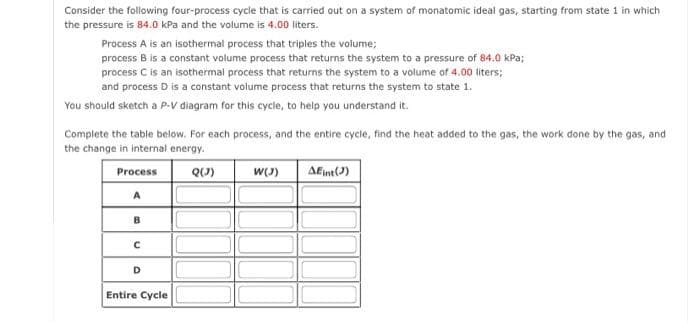Consider the following four-process cycle that is carried out on a system of monatomic ideal gas, starting from state 1 in which the pressure is 84.0 kPa and the volume is 4.00 liters. Process A is an isothermal process that triples the volume; process B is a constant volume process that returns the system to a pressure of 84.0 kPa; process C is an isothermal process that returns the system to a volume of 4.00 liters; and process D is a constant volume process that returns the system to state 1. You should sketch a P-V diagram for this cycle, to help you understand it. Complete the table below. For each process, and the entire cycle, find the heat added to the gas, the work done by the gas, and the change in internal energy. Process QU) W(J) Afint() A D. Entire Cycle
Consider the following four-process cycle that is carried out on a system of monatomic ideal gas, starting from state 1 in which the pressure is 84.0 kPa and the volume is 4.00 liters. Process A is an isothermal process that triples the volume; process B is a constant volume process that returns the system to a pressure of 84.0 kPa; process C is an isothermal process that returns the system to a volume of 4.00 liters; and process D is a constant volume process that returns the system to state 1. You should sketch a P-V diagram for this cycle, to help you understand it. Complete the table below. For each process, and the entire cycle, find the heat added to the gas, the work done by the gas, and the change in internal energy. Process QU) W(J) Afint() A D. Entire Cycle
Chapter3: The First Law Of Thermodynamics
Section: Chapter Questions
Problem 92AP: Two moles of a monatomic ideal gas such as oxygen is compressed adiabatically and reversibly from a...
Related questions
Question

Transcribed Image Text:Consider the following four-process cycle that is carried out on a system of monatomic ideal gas, starting from state 1 in which
the pressure is 84.0 kPa and the volume is 4.00 liters.
Process A is an isothermal process that triples the volume;
process B is a constant volume process that returns the system to a pressure of 84.0 kPa;
process C is an isothermal process that returns the system to a volume of 4.00 liters;
and process D is a constant volume process that returns the system to state 1.
You should sketch a P-v diagram for this cycle, to help you understand it.
Complete the table below. For each process, and the entire cycle, find the heat added to the gas, the work done by the gas, and
the change in internal energy.
Afint()
Process
W()
B
D
Entire Cycle
Expert Solution
This question has been solved!
Explore an expertly crafted, step-by-step solution for a thorough understanding of key concepts.
Step by step
Solved in 3 steps with 3 images

Knowledge Booster
Learn more about
Need a deep-dive on the concept behind this application? Look no further. Learn more about this topic, physics and related others by exploring similar questions and additional content below.Recommended textbooks for you


Principles of Physics: A Calculus-Based Text
Physics
ISBN:
9781133104261
Author:
Raymond A. Serway, John W. Jewett
Publisher:
Cengage Learning

Physics for Scientists and Engineers, Technology …
Physics
ISBN:
9781305116399
Author:
Raymond A. Serway, John W. Jewett
Publisher:
Cengage Learning


Principles of Physics: A Calculus-Based Text
Physics
ISBN:
9781133104261
Author:
Raymond A. Serway, John W. Jewett
Publisher:
Cengage Learning

Physics for Scientists and Engineers, Technology …
Physics
ISBN:
9781305116399
Author:
Raymond A. Serway, John W. Jewett
Publisher:
Cengage Learning

Physics for Scientists and Engineers with Modern …
Physics
ISBN:
9781337553292
Author:
Raymond A. Serway, John W. Jewett
Publisher:
Cengage Learning

Physics for Scientists and Engineers
Physics
ISBN:
9781337553278
Author:
Raymond A. Serway, John W. Jewett
Publisher:
Cengage Learning

Physics for Scientists and Engineers: Foundations…
Physics
ISBN:
9781133939146
Author:
Katz, Debora M.
Publisher:
Cengage Learning